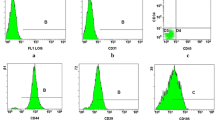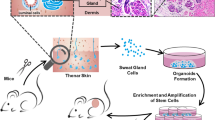Abstract
External auditory canal (EAC) stenosis or atresia usually requires a skin graft to repair, but due to the lack of a graft containing functional glands, postoperative complications such as infection and eczema are common. The aim of this study was to isolate and characterize seed cells for the construction of tissue engineered EAC skin containing ceruminous gland by isolating and cultivating cells of ceruminous gland. In this study, EAC skin samples were harvested from adult goats for ceruminous gland cell isolation. Cell morphology and proliferation rates, expression of CK7, CK8, CK18, and CK19 (glandular cell specific-markers), and secretion of β-defensin-1, lysozyme, and polysaccharides were evaluated at different passages to verify the presence of ceruminous gland cells and determine whether function and proliferation potential were maintained. Ceruminous glands were successfully isolated and extracted from goat EAC skin. Furthermore, the isolated glandular cells maintained robust proliferation potential, exhibited high expression of CK7, CK8, CK18, and CK19, and vigorously secreted β-defensin-1, lysozyme, and polysaccharides in this culture system. However, expression of glandular cell specific-markers and secretory function gradually declined with increasing passage number, indicating dedifferentiation of the subcultured ceruminous gland cells after five passages. In conclusion, ceruminous glands were successfully isolated, cultured, and expanded from goat EAC skin using the serumcontaining culture system. Importantly, the isolated glandular cells retained robust proliferation potential and maintained their phenotype and function in early passages (P1–P3), indicating the method’s potential application for ceruminous gland regeneration.







Similar content being viewed by others
Data availability
Not applicable.
Code availability
Not applicable.
References
Chai TJ, Chai TC (1980) Bactericidal activity of cerumen. Antimicrob Agents Chemother 18:638–641
Gao Y, Li M, Zhang X, Bai T, Chi G, Liu JY, Li Y (2014) Isolation, culture and phenotypic characterization of human sweat gland epithelial cells. Int J Mol Med 34:997–1003
Kataura A, Kataura K (1967) The comparison of lipids between dry and wet types of cerumen. Tohoku J Exp Med 91:227–237
Lee CM, Carpenter F, Coaker T, Kealey T (1986) The primary culture of epithelia from the secretory coil and collecting duct of normal human and cystic fibrotic eccrine sweat glands. J Cell Sci 83:103–118
Li H, Chen L, Zhang M, Tang S, Fu X (2013) Three-dimensional culture and identification of human eccrine sweat glands in matrigel basement membrane matrix. Cell Tissue Res 354:897–902
Li C, Zhang T, Fu Y, Qing F, Chi F (2014) Congenital aural atresia and stenosis: surgery strategies and long-term results. Int J Audiol 53:476–481
Li H, Chen L, Zeng S, Li X, Zhang X, Lin C, Zhang M, Xie S, He Y, Shu S (2015) Matrigel basement membrane matrix induces eccrine sweat gland cells to reconstitute sweat gland-like structures in nude mice. Exp Cell Res 332:67–77
Mandour MA, El-Ghazzawi EF, Toppozada HH, Malaty HA (1974) Histological and histochemical study of the activity of ceruminous glands in normal and excessive wax accumulation. J Laryngol Otol 88:1075–1085
Narushima M, Yamasoba T, Iida T, Sakamoto T, Kashio A, Karino S, Yamamoto T, Kikuchi K, Mihara M, Koshima I (2013) Supermicrosurgical reconstruction for congenital aural atresia using a pure skin perforator flap: concept and long-term results. Plast Reconstr Surg 131:1359–1366
Schwaab M, Gurr A, Neumann A, Dazert S, Minovi A (2011) Human antimicrobial proteins in ear wax. Eur J Clin Microbiol Infect Dis 30:997–1004
Shichijo S, Masuda H, Takeuchi M (1979) Carbohydrate composition of glycopeptides from the human cerumen. Biochem Med 22:256–263
Sirigu P, Perra MT, Ferreli C, Maxia C, Turno F (1997) Local immune response in the skin of the external auditory meatus: an immunohistochemical study. Microsc Res Tech 38:329–334
Stoeckelhuber M, Matthias C, Andratschke M, Stoeckelhuber BM, Koehler C, Herzmann S, Sulz A, Welsch U (2010) Human ceruminous gland: ultrastructure and histochemical analysis of antimicrobial and cytoskeletal components. Anat Rec A 288:877–884
Stone M, Fulghum RS (1984) Bactericidal activity of wet cerumen. Ann Otol Rhinol Laryngol 93:183–186
Teufert KB, De la Cruz A (2004) Advances in congenital aural atresia surgery: effects on outcome. Otolaryngol Head Neck Surg 131:263–270
Wang J, He A, Yin D, Zhu Y, Zhou G, Zhang T (2021) Comparative study of the external auditory canal in humans and large mammals. Anat Rec (Hoboken, NJ). https://doi.org/10.1002/ar.24685
Yildirim N, Yildirim N, Sahan M, Kasapoğlu F (2009) Two-stage aural atresia and stenosis surgery with the use of synthetic skin substitute. Acta Otolaryngol 129:1072–1079
Acknowledgements
This work was supported by the National Natural Science Foundation of China (82172105, 31700837, 81771014).
Funding
This work was supported by the National Natural Science Foundation of China (31700837, 81800920, 81771014).
Author information
Authors and Affiliations
Corresponding author
Ethics declarations
Conflict of interest
The authors have no conflict of interest to declare.
Ethical approval
This study was approved by the Ethics Committee and the Institutional Review Board of the Eye & ENT Hospital of Fudan University (Shanghai, P.R. China). All animal experiments were carried out in accordance with the U.K. Animals (Scientific Procedures) Act, 1986 and associated guidelines, EU Directive 2010/63/EU for animal experiments.
Consent to participate
Not applicable.
Consent for publication
Not applicable.
Additional information
Publisher’s Note
Springer Nature remains neutral with regard to jurisdictional claims in published maps and institutional affiliations.
Rights and permissions
About this article
Cite this article
Wang, J., He, A., Zhu, Y. et al. Isolation, culture, and identification of ceruminous gland cells. J Mol Histol 53, 227–237 (2022). https://doi.org/10.1007/s10735-021-10040-y
Received:
Accepted:
Published:
Issue Date:
DOI: https://doi.org/10.1007/s10735-021-10040-y




